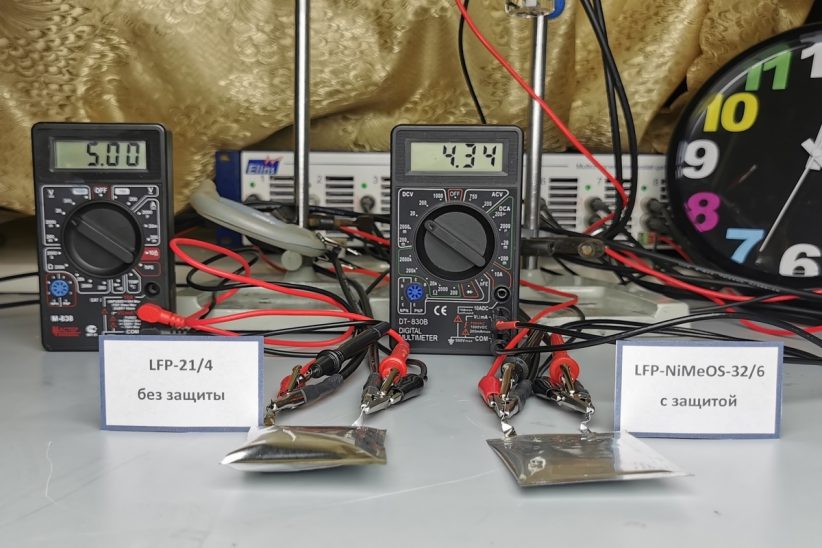A group of scientists from St Petersburg University has created a new technology to protect lithium-ion batteries from fire hazards. They suggest using a “chemical fuse” — a special protective layer made of a conductive polymer-to cover the battery current collector. In the event of an emergency, it breaks the electrical circuit, saving the device from fire.
The prototypes of a protected (right) and conventional (left) battery after an emergency situation — overcharging. An ordinary battery is swollen due to the released gases and may explode. The protected
battery remained flat.
The results of the research, supported by an RNF grant, are published in the “Journal of Power Sources”. According to the head of the group of scientists, Professor of the Department of Electrochemistry of St Petersburg State University Oleg Levin, the ignition of lithium-ion batteries is a common problem faced by owners of a wide variety of devices – from smartphones to electric cars. “Between 2013 and 2018, 25,000 cases of battery fires in various devices were recorded in the United States alone. At the same time, previously, from 1999 to 2013, there were only 1013 cases of fires established. Thus, the numberof fire hazards increases along with the number of batteries used,” the scientist points out.
The main causes of battery unintentional fires are overcharging, short-circuit, or other emergency situations. As a result, the battery begins to heat up and the so-called thermal acceleration occurs.
When the temperature reaches 70-90 degrees, undesirable chemical reactions occur in the battery, which provoke a further increase in temperature, which, in an extreme case, leads to flame condition or explosion. To protect the batteries, an external device is usually used — an electronic chip. This circuit monitors all the parameters of the battery or accumulator and turns it off in the event of critical
situation. However, in most cases the fires have occurred due to the fact of electronic circuit failure, for example, due to the factory defect.
That is why it was important to come up with an idea of a protection mechanism that would work on chemical principles – so that, if necessary, certain chemical processes inside the battery would block the flow of current. Such a mechanism was a special polymer proposed by the group. The head of the group of scientists, Professor of the Department of Electrochemistry of St Petersburg State University, Oleg Levin. “Its electrical conductivity changes depending on the voltage in the battery. If the battery is working normally, the polymer perfectly conducts the current. But if an overcharge condition occurs in the battery, the polymer becomes an insulator. It similarly works if there is a short circuit condition and the battery voltage falls below the nominal limits, “ Oleg Levin explains. According to the scientist, there exist polymers that change their resistance when heated. The problem with this technology, which has been tried to be implemented, including St Petersburg enterprises, is that if this polymer actuates, it means that the battery has already started to heat up and undesirable processes are going on in it, which cannot always be stopped by simply opening the circuit. That is why this method of protection cannot be called effective. However, such designs have become the impetus for the search of a polymer that changes its resistance even before the battery starts to heat up.
The co-author of the study, a post graduate student at the Department of Electrochemistry, Yevgeny Beletskiy, used to work in the industry. His experience in developing real battery protection systems was very useful in the experimental part of the work on the polymer.
Professor of the Department of Electrochemistry of St Petersburg State University Oleg Levin “Another post graduate student of the department — Anna Fedorova, who also has work experience in
the industry, was engaged in the calculation of the physical and chemical properties of the material,” says Oleg Levin. The work on creating the technology took about two years. Prior to this, for six years, scientists had conducted fundamental research on the physical and chemical properties of various polymer materials. As a result, a class of polymers was discovered, the resistance of which varies depending on the voltage.
It is on them that the scientists focused.
“The most difficult thing in the development of the “chemical fuse” was the search for a specific active polymer material. We knew a lot about polymers of this class, but it was not so easy to choose one that would be suitable not only as an idea, but also when creating a prototype, ” Oleg Levin notes. — In addition, it was necessary to work out the technology — to create a semi-industrial sample to demonstrate that the protection is effective. This required the purchase of a large amount of new equipment for prototyping and testing methods for working with components of lithium-ion batteries.”
An important feature of the new protection technology is its simple scalability. For example, the size of traditional external protection circuits depends on the battery power. Respectively, the protection scheme for the propulsion system battery of an electric car will be not just large, but also expensive. Scaling the “chemical fuse” is much easier — its layer is applied over the entire surface of the internal current collector.
“When producing lithium-ion batteries, different types of cathodes are used — electrical conductors, to which the movement of electrons is directed. They have different operating voltages, and, accordingly, in each case, the protective polymer should behave differently. At the moment, we have selected a polymer for only one type of battery — lithium-iron-phosphate. If we change the structure of the polymer, the hope is that we can shift the window of conductivity so that it fits other types of cathodes that exist on the market. In addition, there is an idea to make the protection more universal by adding protection to the polymer that acts when the temperature changes in the battery. This will eliminate all possible causes of fire, “ says Oleg Levin.
Before the publication of the article, St Petersburg State University had received a patent for the invention of its scientists. Currently, the authors of the study are preparing full-size models of protected batteries in the laboratory for demonstration to potential investors. The work was supported by the RPF grant 19-19-00175.





